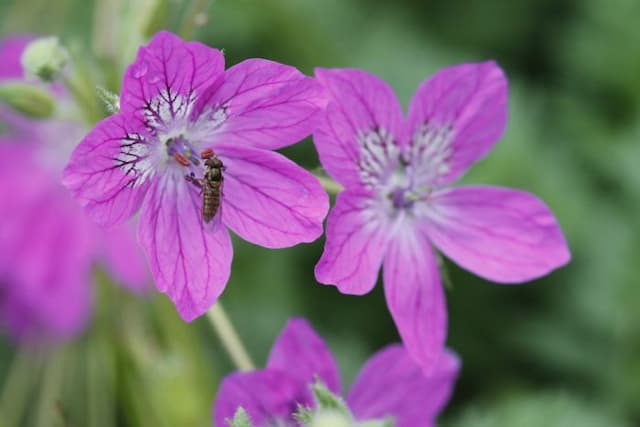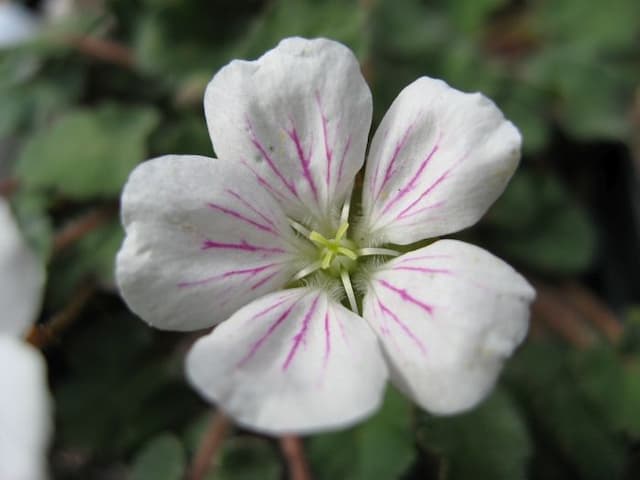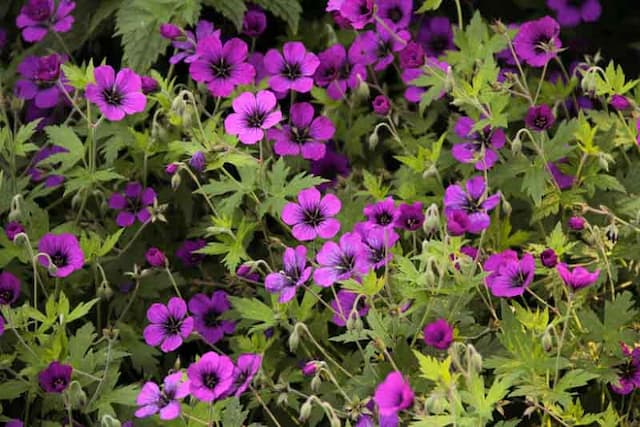Scented Geranium Pelargonium 'Irene' (Z/d)

ABOUT
Pelargonium 'Irene' is a striking plant with features that make it stand out in any garden space. The leaves are intricately designed, showcasing a deep green color with a unique zonal pattern that often includes a darker hue or burgundy tone in the center, creating a stunning contrast. These rounded leaves grow with a soft, somewhat velvety texture, adding a lush and tactile element to the plant's foliage. The flowers of Pelargonium 'Irene' are its most captivating attribute, presenting a vibrant display of blooms that can range in color. Typically, the flowers emerge as clusters atop slender stems which rise above the foliage, creating a delightful canopy of color. Each flower consists of five petals that are frequently adorned with delicate markings or streaks, adding depth and dimension to the bloom's appearance. Overall, Pelargonium 'Irene' has a bushy, robust form, with its stems and branches forming a dense and shapely silhouette. Its generous production of foliage and flowers contributes to a full and rounded appearance that is aesthetically pleasing in a variety of settings, from garden beds to container plantings.
About this plant
 Names
NamesSynonyms
Irene Geranium, Irene Pelargonium.
Common names
Pelargonium 'Irene' (Z/d).
 Toxicity
ToxicityTo humans
Geraniums are generally not toxic to humans. However, some people may experience mild irritation or an allergic reaction if they handle the plants and have sensitive skin. If ingested in large quantities, they may cause gastrointestinal upset, but they are not known to be seriously poisonous to humans. It is always best to avoid consuming any part of ornamental plants due to potential unknown effects.
To pets
Geraniums can be toxic to pets, especially to cats and dogs. If ingested, these plants may cause symptoms such as vomiting, anorexia, depression, and dermatitis. In particular, the essential oils and some other compounds in geraniums can cause these adverse effects. It's important to keep these plants out of reach of pets to prevent any potential toxicity. If you suspect your pet has ingested geranium, it is recommended to contact a veterinarian promptly.
 Characteristics
CharacteristicsLife cycle
Perennials
Foliage type
Evergreen
Color of leaves
Green
Flower color
Varies
Height
1-2 feet (30-60 cm)
Spread
1-2 feet (30-60 cm)
Plant type
Herb
Hardiness zones
10
Native area
South Africa
Benefits
 General Benefits
General Benefits- Decorative Appearance: Pelargonium 'Irene', commonly known as Geranium, offers vibrant and colorful blooms that can enhance the aesthetic of gardens and living spaces.
- Low Maintenance: Geraniums are relatively easy to care for, requiring minimal watering and fertilizing, making them ideal for busy plant owners or beginners.
- Tolerance to Heat and Drought: They are known for their ability to withstand hot and dry conditions, which is particularly beneficial in arid climates or during summer months.
- Long Blooming Season: Geraniums have a long flowering period, which can last from spring through fall, providing continuous color in the landscape.
- Pest Resistance: These plants are often resistant to common garden pests, reducing the need for chemical pesticides.
- Adaptability: They can thrive in a variety of conditions, from full sun to partial shade, and can be grown in containers, hanging baskets, or garden beds.
- Attracts Beneficial Insects: Geraniums can attract pollinators like bees and butterflies to the garden, which are essential for the pollination of many plants.
 Medical Properties
Medical PropertiesThis plant is not used for medical purposes.
 Air-purifying Qualities
Air-purifying QualitiesThis plant is not specifically known for air purifying qualities.
 Other Uses
Other Uses- Herbal Teas: Scented geranium leaves, such as those from Pelargonium 'Irene', can be used to infuse herbal teas with a subtle rose-like flavor and aroma.
- Aromatherapy: The essential oils extracted from scented geraniums can be used in diffusers or as part of homemade aromatherapy blends for their calming and uplifting properties.
- Culinary Garnishes: The flowers and scented leaves of the scented geranium can be used to garnish desserts or salads, adding an elegant touch to the presentation.
- Natural Dye: The leaves and petals of scented geraniums can be used to produce natural dyes for fabrics or crafting, offering a range of colors depending on the plant parts used.
- Bath Additives: Leaves from the scented geranium can be added to bathwater for a fragrant, skin-soothing soak.
- Companion Planting: Scented geraniums can be planted in the garden to help repel pests and insects with their strong scent, thereby protecting nearby plants without the use of chemicals.
- Homemade Potpourri: Dried leaves and flowers from the scented geranium can be included in potpourri mixes to impart a pleasant fragrance to your home.
- Scented Ink: Juice from the scented geranium leaves can be mixed with a base to create naturally scented ink for use in fountain pens or brushwork.
- Flavoring Sugar: Leaves from the scented geranium can be layered with sugar to create a delicately scented sweetener for teas, baking, or confectionery.
- Drawer Sachets: Dried scented geranium leaves and flowers can be sewn into small sachets and placed in drawers or closets to impart a gentle aroma to clothing and linens.
Interesting Facts
 Feng Shui
Feng ShuiThe Geranium is not used in Feng Shui practice.
 Zodiac Sign Compitability
Zodiac Sign CompitabilityThe Geranium is not used in astrology practice.
 Plant Symbolism
Plant Symbolism- Comfort: The soft, pleasant scent often associated with geraniums like Pelargonium 'Irene' can symbolize comfort and the soothing of anxieties.
- Friendship: Sharing cuttings of geraniums can represent the sharing of friendships or the wish to maintain a friendly relationship.
- Health: Geraniums are often believed to promote good health and vitality, as they have historically been used in folk medicine.
- Fertility: The abundant growth and reproduction of geraniums through cuttings may symbolize fertility or creativity.
- Positive Emotions: The bright and varied colors of geranium flowers often evoke positivity, happiness, and good spirits.
 Water
WaterGeranium 'Irene' prefers soil that is kept evenly moist. During the growing season, water when the top inch of soil feels dry, which may be about once a week. However, frequency should be adjusted depending on climate, humidity, and indoor conditions. Each watering should be thorough, saturating the soil until excess water drains out of the bottom of the pot, using approximately one to two gallons depending on pot size and plant size for each watering session. During winter, reduce watering to every two weeks or when soil is dry to touch as growth slows down.
 Light
LightGeranium 'Irene' thrives best in bright, indirect sunlight. It should be placed in a spot where it can receive at least six hours of sunlight daily, but protected from the harsh afternoon sun which can scorch its leaves. An east or west-facing window is ideal for providing the optimal light conditions required for healthy growth.
 Temperature
TemperatureGeranium 'Irene' prefers a temperature range of 55 to 70 degrees Fahrenheit for optimal growth. It can tolerate minimum temperatures down to 30 degrees Fahrenheit and maximum temperatures up to 80 degrees Fahrenheit but should be protected from frost and extreme heat. The ideal conditions are a consistently warm environment with good air circulation.
 Pruning
PruningGeranium 'Irene' should be pruned to encourage bushier growth and to remove dead or yellowing leaves and spent blooms. The best time to prune is in early spring and again after flowering. Pruning every two to three months helps maintain its shape and promotes healthier, more vigorous plants.
 Cleaning
CleaningAs needed
 Soil
SoilFor Geranium 'Irene', a well-draining potting mix with peat, perlite, and vermiculite is best, and the soil pH should range from 6.0 to 7.5.
 Repotting
RepottingGeranium 'Irene' typically should be repotted every one to two years to refresh the soil and accommodate root growth.
 Humidity & Misting
Humidity & MistingGeranium 'Irene' does well in average home humidity levels but prefers slightly drier conditions than many other houseplants.
 Suitable locations
Suitable locationsIndoor
Place in bright indirect light and ensure good air circulation.
Outdoor
Full to partial sun, shelter from strong winds, well-draining spot.
Hardiness zone
10-11 USDA
 Life cycle
Life cycleThe life of Pelargonium 'Irene', commonly known as Irene Geranium, begins with seed germination, where the seed needs warm temperatures and moist soil to sprout. Next is the seedling stage, where the sprouts develop their first true leaves, requiring adequate light and water to grow effectively. Following this, the vegetative stage sees the plant grow in size and foliage through photosynthesis, and it's during this time that Irene Geranium might be pinched back to encourage bushier growth. The flowering stage follows when the plant matures and develops flower buds that bloom into the characteristic colorful flowers, often with proper care and deadheading to encourage repeated blooming. After flowering, if allowed to pollinate, the plant will produce seeds, thus enabling potential propagation and the continuation of the cycle. As the seasons change or under suboptimal conditions, Irene Geranium may enter a period of dormancy, especially in cooler climates, where it conserves energy until favorable conditions return.
 Propogation
PropogationPropogation time
Spring-Early Summer
The most popular method of propagating Pelargonium 'Irene', also known as geranium 'Irene', is through stem cuttings. This is best done in late summer to early fall. Choose a healthy, non-flowering stem that is about 4 to 6 inches (10 to 15 cm) long. Cut the stem just below a node, where the leaf joins the stem, using a clean, sharp knife or scissors. Remove any leaves from the lower half of the cutting to prevent rot when planted. Dip the cut end into rooting hormone powder to encourage root development, and then plant the cutting in a pot filled with a well-draining soil mix. Water the cutting and place it in a warm, bright spot out of direct sunlight until it roots, which usually takes about 3 to 4 weeks.









![Cranesbill [Rothbury Gem]](/_next/image?url=https%3A%2F%2Fplants-admin.emdemapps.com%2Fimages%2Fplants%2F%2Fimages%2F604b6243984c2.png&w=640&q=75)